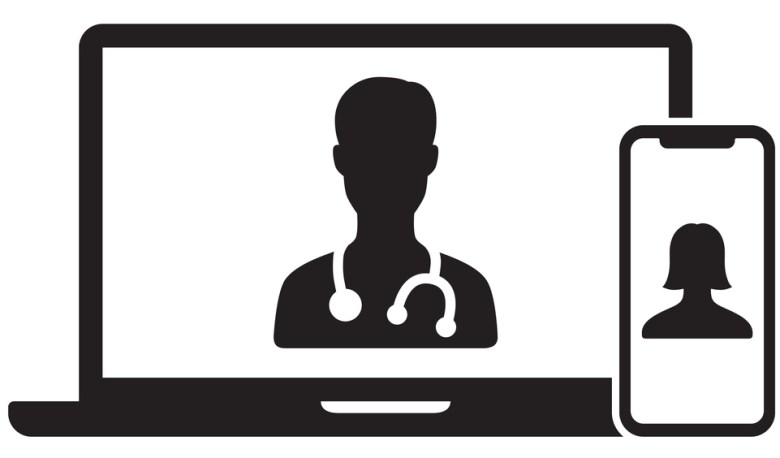

By Micha Green
AFRO D.C. and Digital Editor
mgreen@afro.com
Telemedicine, also referred to as “telehealth,” allows patients to see a doctor or healthcare provider without being in person. From physical therapy, to internists to psychiatrists, telemedicine happens every day and this reporter has experienced it over the pandemic firsthand. While there are several strengths to check on your health through telemedicine (particularly for this germaphobe reporter), it is also important to note that it does not replace the major benefits of in-person doctor visits.
Telehealth allows for patients to talk to their doctor live over the phone or video chat, send and receive messages through online portals or via email or secure messaging, or use report monitoring of vital signs, according to Telehealth.hhs.gov. Further, telemedicine treatment includes therapy and online counseling, address urgent care conditions such as colds, coughs and stomach aches or for common, recurring conditions such as migraines and urinary tract infections, skin conditions, prescription management, relaying x ray or lab test results and post surgical follow ups.
According to Telehealth.hhs.gov, telemedicine appointments are beneficial as they: reduce exposure to COVID-19; ensure health care wherever patients may be, including their homes, cars or offices; cut down on travel costs and time and prevents the need from taking off of work or finding childcare options; can shorten the wait time for an appointment; and sometimes increases the ability to speak healthcare practitioners outside of one’s hometown.
For many reasons, the above list of telemedicine pros has been ideal for this reporter as I have worked between the nation’s capital and Chicago while taking care of my ailing mother. Telehealth visits allowed for me to check-in on my own health from Chicago with my primary care practitioners in D.C. and stay near my mother while she needed my regular care throughout the day.
Once my mother’s health improved and doctors she had seen in-person became more familiar with her case, telemedicines allowed for my mother to check in with her health care providers without constantly heading to crowded and hard to navigate hospitals and doctors’ offices.
Through telehealth appointments, my mother and I have successfully received diagnosis and prescription medications.

Further, telemedicine has been key for patients and practitioners alike, as we all navigate the new normals of the COVID-19 pandemic. For almost four weeks, I fought a lingering cough that would not let up. To avoid exposure to COVID-19, my doctor’s office allowed telemedicine calls to check in before I was seen in person. I was able to receive medicines that would help with the challenges of and to suppress the symptoms I was facing, but the cough itself would not fully stop. After three negative COVID tests and a continued cough, I did go to an in-person appointment, but due to the telemedicine care, my doctor, who had already communicated with me a couple of times online, was able to quickly assess me, test me, diagnose me and send me home with a prescription for antibiotics.
With the mask requirements associated with the COVID-19 pandemic, though not in person, telemedicine allows for practitioners and patients to speak face to face. Despite being necessary for safety, masks mumble words and sometimes make communication challenging. Some practitioners, such as speech therapists and psychiatrists appreciate the value in telemedicine in truly connecting with their patients.
“Whenever anyone faces insult or injury, be it physical, emotional or mental, rehab Ilaria’s is recommended to bring that person to a place of healing and wellbeing. As a speech pathologist, it is my goal to develop a person’s ability to community to a place of empowerment. The ability to be heard and understood effectively and efficiently is the number one priority. Therefore,when communication is interrupted by insult or injury, it is important to not delay this essential process of returning to your place of empowerment,” Speech Pathologist LaChone Pitchford told the {AFRO}. “As we move through the restrictions of the pandemic, many have found it difficult to adjust to the temporary normal of deceased access. However, through the power of technology, we are able to restore empowerment and provide the pathway to healing. It is my pleasure to be a light on that pathway. Healing, health, empowerment is only a click away, so please, if you know anyone who is grappling with decreased access, encourage them not to delay, but to reach out for help today!”
Also, in using certain electronic devices, doctors can monitor patients’ vitals through telehealth and ensure that they are doing well.
Finally, telemedicine allows family members in other parts of the country and world to connect with doctors, medical teams and sometimes the patients. During the COVID-19 pandemic, it is through telehealth portals and tablets that some family members spoke to their loved one’s medical team or even used technology to say goodbye.
When my mother was in rehabilitation after a stroke, pandemic rules only allowed one family member- me- to be present for training on how to help her once she was released from in-patient care. Telemedicine was key in training family members on the proper techniques to keep her safe as she was regaining mobile independence. Telehealth appointments also allowed relatives to ask questions and gain clarity on a number of topics as they could not be there in person. Now that my mother is much better, she uses telehealth appointments, regularly, to check in with providers.
Now let’s be clear, with the benefits of telemedicine, telehealth appointments are not the end all be all of the checking on one’s health journey. As was the case with my lingering cough, the symptoms continued and I eventually needed to be treated in person in order to get to the root of my problem.
There’s a lot that cannot be accomplished through telehealth alone and sometimes patients must be seen in person.
Lab tests and x-rays are often necessary for diagnosis and that cannot be accomplished using telemedicine. In addition, practitioners cannot personally touch concerning areas or physically adjust patients if they are doing hands-on therapy such as in speech, occupational or physical therapies.
Finally , there are simply things that practitioners cannot catch or patients might forget with telemedicine.
If the pandemic era has taught the world anything, it is that a lot can be done with the help of the world wide web.
“Expanded telehealth is one of the best things to come out of the pandemic,” read on Tweet with 35 likes and three retweets.
Telehealth is one of many useful tools that strengthened and blossomed during the COVID-19 pandemic. While not everything concerning health can be accomplished through telehealth, it makes for a strong resource in the world of medicine.
Telehealth will continue post the pandemic. The University of Connecticut Center for mHealth (media Health) and Social Media posted that it is hosting a conference called “Telehealth and Remote Care in a Post-Pandemic World May of 2022.
Further, legislators are taking note of the importance of telehealth. Four U.S. Senators introduced a bipartisan bill, the {Expanded Telehealth Access Act}, which would ensure Medicare reimbursement eligibility for occupational therapists, speech-language pathologists and audiologists, as well allow for the Health and Human Services Secretary to add more specialty practitioners to that list. In addition, the Bipartisan Infrastructure Deal invests $65 billion into affordable broadband, which ensures, according to U.S. Department of Commerce Secretary Gina Raimondo, “every American can participate in the modern economy.”
“This investment will connect every American to life-saving telehealth,” Raimondo tweeted on Nov. 13.
Some telehealth resources include: Total Health (internists, pediatricians, mental health, dentists, etc…)- ZocDoc and Teladoc; for Mental Health- The Boris L. Henson Foundation and BetterHelp.com and for Urgent Care visit HealthTap.com. Medicaid and Children’s Health Insurance Programs (CHIP) also provides a “Medicaid & CHIP Telehealth Toolkit.”
Help us Continue to tell OUR Story and join the AFRO family as a member – subscribers are now members! Join here!
The post Telemedicine: Checking in on health virtually appeared first on AFRO American Newspapers .











